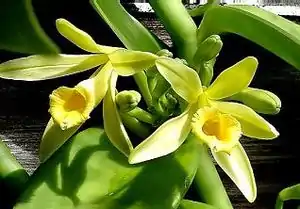Vanillylalkohol
Vanillylalkohol (4-Hydroxy-3-methoxybenzylalkohol) ist eine organisch-chemische Verbindung, die natürlich in verschiedenen Pflanzen wie der Gewürzvanille (Vanilla planifolia),[5] und der Sitka-Fichte (Picea sitchensis) vorkommt.[2] Die Substanz leitet sich strukturell sowohl vom Benzylalkohol, als auch vom Guajacol (o-Methoxyphenol) ab. Die weißen oder farblosen Kristalle mit mildem, süßlichem, vanille-artigem Geruch lösen sich nur wenig in Wasser, aber gut in Ölen.[1]
| Strukturformel | ||||||||||||||||||||||
|---|---|---|---|---|---|---|---|---|---|---|---|---|---|---|---|---|---|---|---|---|---|---|
 | ||||||||||||||||||||||
| Allgemeines | ||||||||||||||||||||||
| Name | Vanillylalkohol | |||||||||||||||||||||
| Andere Namen |
4-Hydroxy-3-methoxybenzylalkohol | |||||||||||||||||||||
| Summenformel | C8H10O3 | |||||||||||||||||||||
| Kurzbeschreibung |
weiße oder farblose Kristalle mit mildem, süßlichem, vanille-artigem Geruch[1] | |||||||||||||||||||||
| Externe Identifikatoren/Datenbanken | ||||||||||||||||||||||
| ||||||||||||||||||||||
| Eigenschaften | ||||||||||||||||||||||
| Molare Masse | 154,17 g·mol−1 | |||||||||||||||||||||
| Aggregatzustand |
fest | |||||||||||||||||||||
| Schmelzpunkt | ||||||||||||||||||||||
| Löslichkeit | ||||||||||||||||||||||
| Sicherheitshinweise | ||||||||||||||||||||||
| ||||||||||||||||||||||
| Soweit möglich und gebräuchlich, werden SI-Einheiten verwendet. Wenn nicht anders vermerkt, gelten die angegebenen Daten bei Standardbedingungen. | ||||||||||||||||||||||

Eine katalytische Hydrierung von Vanillin führt zu Vanillylalkohol bzw. zu 2-Methoxy-4-methylphenol.[6]
Die Vanillylalkohol-Oxidase katalysiert die Oxidation verschiedener phenolischer Verbindungen, vor allem zahlreiche 4-Alkylphenole.[7] Ursprünglich wurde in vitro die Oxidation von Vanillylalkohol zu Vanillin nachgewiesen:
 + O2 ⇒
+ O2 ⇒  + H2O2
+ H2O2
Vanillylalkohol besitzt in den Vereinigten Staaten eine Einstufung als FEMA GRAS (Generally Recognized As Safe, FEMA GRAS#3737)[8] und kann damit dort als Lebensmittelzusatzstoff eingesetzt werden.
Siehe auch
Einzelnachweise
- Shmuel Yannai: Dictionary of Food Compounds with CD-ROM: Additives, Flavors, and Ingredients. CRC Press, 2003, ISBN 978-1-58488-416-3, S. 307.
- D. C. Ayres (Hrsg.): Dictionary of Natural Products, Volume 6. CRC Press, 1994, ISBN 978-0-412-46620-5, S. 1562.
- Eintrag zu Vanillyl alcohol in der ChemIDplus-Datenbank der United States National Library of Medicine (NLM)
- Datenblatt Vanillyl alcohol bei Sigma-Aldrich, abgerufen am 25. April 2011 (PDF).
- VANILLYL-ALCOHOL (engl., PDF) In: Dr. Duke's Phytochemical and Ethnobotanical Database, Hrsg. U.S. Department of Agriculture, abgerufen am 28. November 2021.
- Riechstofflexikon: Vanillin.
- A. Mattevi, M. W. Fraaije, A. Mozzarelli, L. Olivi, A. Coda, W. J. van Berkel: Crystal structures and inhibitor binding in the octameric flavoenzyme vanillyl-alcohol oxidase: the shape of the active-site cavity controls substrate specificity. In: Structure. Band 5, Nr. 7, 1997, S. 907–920, doi:10.1016/S0969-2126(97)00245-1, PMID 9261083.
- George A. Burdock: Encyclopedia of food and color additives, Volume 3. CRC Press, 1997, ISBN 978-0-8493-9414-0, S. 2903.
Weblinks
- Eintrag zu Vanillylalkohol. In: P. J. Linstrom, W. G. Mallard (Hrsg.): NIST Chemistry WebBook, NIST Standard Reference Database Number 69. National Institute of Standards and Technology, Gaithersburg MD
